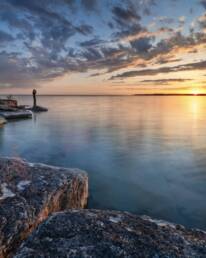July 15, 2022 | Photographer: © Peter Baumgarten
Manitoulin Island
Welcome to the largest freshwater lake island on the planet. Odawa Mnis (a.k.a. Manitoulin Island) is known for the natural beauty found in its winding trails, views of Lake Huron and Georgian Bay and over one hundred inland lakes. As home to six First Nation communities, including the famously unceded Wiikwemkoong, as well as nearby Whitefish River and Sagamok First Nations, the Island is imbued with Indigenous history and culture.
Day One
MORNINGWIIKWEMKOONG
A PROUD HERITAGE
Wiky, as it’s known locally, is unique in being unceded Indigenous territory, meaning the rights to the land were never signed away to any nation. Guided tours are one way of learning about this proud heritage, with a range of tour possibilities depending on the day. Paddle through fishing islands along Lake Huron and gaze upon the La Chloche Mountain range on the “Bay of the Beaver Canoe” tour. “The Unceded Journey” tour takes you to historic sites to gain an understanding of the seminal 1836 and 1862 treaties, and to learn local lore and legend. Wikwemikong Tourism is your port of call to find out more and to book tours. Speaking of booking tours, you may also want to look into the possibility of a viewing at the Mishibinijima Private Art Gallery where you’ll see the stunning work of artist James Mishibinijima.
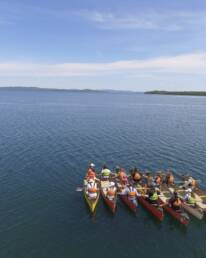
AFTERNOONBEBAMIKAWE MEMORIAL TRAIL
EXPLORING THE TRAIL
As a visitor to Wiky you’re invited to learn more about traditions of the Anishinaabek people of the Three Fires Confederacy: Ojibwe, Odawa, and Potawatomi. One way to do this is through events (notably the Annual Cultural Festival, one of the largest Pow Wows in north-eastern North America). You can also take time to walk some of the professionally built 12 kilometres of trails collectively known as the Bebamikawe Memorial Trail. Scenic lookout points provide information about Anishinaabek history and beautiful views of the North Channel and Georgian Bay. Fitness fans can lace up for the one-and-a-half kilometre (bicycle-friendly) training trail, and birders should definitely bring the binos.
Speaking of varied passions, en route to Little Current you’ll find the Rainbow Ridge Golf Course, one of many primarily Indigenous-owned businesses on the Island, located outside of the village of Manitowaning. Manitowaning is also home to critically acclaimed Debajehmujig Theatre Group, part of Debajehmujig Storytellers, a multi-disciplinary arts organization dedicated to the revitalization of the Anishnaabek culture, language and heritage. The site is open all day, and offers a gallery in addition to their theatre shows. Among their ground breaking work is 2022’s conclusion of an international trilogy that began in Mexico and Ireland — make sure to check the Debajehmujig website for any upcoming performances.
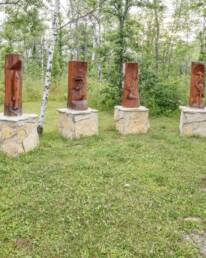
EVENINGLITTLE CURRENT
BOATS, BBQ AND BREWS
A twenty-five minute drive brings you from Manitowaning to Little Current, the island’s four-season access point via the famous swing bridge. It’s also the Island’s largest town, so yes, an excellent spot for dinner. Popular spots include Manitoulin Brewing Company and Brewgers food truck, Elliott’s (classic Canadian cuisine) and The Anchor Inn Hotel (known for its whitefish). Three Cows and A Cone is fun option for pizza and (no surprise) ice cream. An after-dinner boardwalk stroll lets you peek at boats from all over the Great Lakes, as well as some from farther afield — makes sense, given that Georgian Bay’s north channel is considered some of the best freshwater boating anywhere. For live music visit Little Current in August to hit up the annual rock and country music festivals.
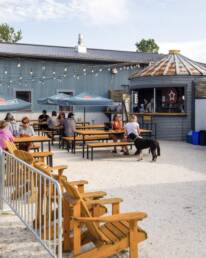
Day Two
MORNINGCUP AND SAUCER TRAIL
CUP, SAUCER AND A HIKE – MICHIGIWADINONG
One of the Island’s best known attractions is The Cup and Saucer/Michigiwadinong trail, about a twenty minute drive west of Little Current on the Manitoulin extension of the Niagara Escarpment. Michigiwadinong means “bluff in the shape of a spearhead,” a reference to it being the place where famous trickster Nanabush lay down his spearpoints while fleeing Iroquois warriors (warriors he’d tormented for generations). The legend and the surrounding area’s history makes it an iconic spot. It’s also a hiker’s delight, with twelve kilometres of trails creating multiple options from fifteen minutes to four hours. There are good reasons it’s one of Ontario’s most popular hikes — magnificent 70 meter cliffs, wonderful views of the Island’s lakes and fields, and closeups of escarpment rock.
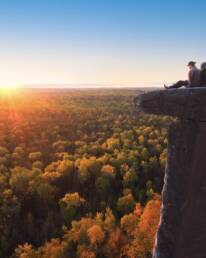
MORNINGM’CHIGEENG
HISTORY AND HERITAGE CRAFTS
You’ll find the Ojibwe Cultural Foundation in M’Chigeeng, with its museum, art gallery, gift shop and amphitheatre. Learn about Anishinaabe spiritual knowledge, history and cultural practices at the museum, and enjoy beautiful heritage crafts including porcupine quill boxes, ash and sweetgrass baskets, and antler carvings. Crafters and artists may also enjoy this area as it is home to Lillian’s Crafts (offering items made from local materials and artwork by Indigenous artists), as well as the original source for the much lauded Beam Paints (pigments harvested from the LaCloche mountain range).
Next, lunch. Maggie’s Café offers home cooking (literally — Maggie’s recipes are passed down from “Great Grandma Agnes Roy, Maggie Roy and Betsy Debassige”). Another option, Maja’s Garden Bistro, is a short jog south of town and is known for local food and organic baking. Film buff alert: the Weengushk Film Institute (an artist-focused film and TV training centre) is based in M’Chigeeng, and collaborates with the Weengushk International Film Festival to showcase work by Indigenous and diverse filmmakers.
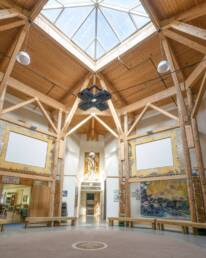
AFTERNOONKAGAWONG
“ONTARIO’S PRETTIEST VILLAGE”
Kagawong, located midway between between M’Chigeeng and Gore Bay, has been called Ontario’s prettiest village and no question it’s a picturesque waterfront town. That handsome limestone building you’ll spot is the Old Mill Heritage Centre, a former pulp mill turned art gallery and museum. Learn about the Island’s agricultural, military and shipping/fishing history, as well the tragic tale of Daniel Dodge, a scion of the automotive family of the same name. Kagawong is also home to Odemin Gallery, specializing in carving using wood, stone and bone found on the Island. Odemin is also a source for tours of the Cup and Saucer trail and the area’s most famous attraction, Bridal Veil Falls, a hidden gem of a waterfall. Swimmers come prepared. On a warm day you may want to traipse down the staircase and enjoy a dip below the falls.

EVENINGPROVIDENCE BAY
SPECTACULAR SAND AND SUNSETS
Providence Bay is known for its spectacular sand beach — and equally spectacular sunsets. Originally called Bebekodawangog, meaning “where the beach curves around the water,” the story goes that it was settler survivors of a shipwreck who first referred to it as Providence. Shallow water makes it a family swimming destination, and it’s a draw for lake trout and salmon fishing. Gaze at Lake Huron from what’s arguably the best beach in Northern Ontario, or stroll the boardwalk, possibly with a cone in hand from Huron Island Time. For something more substantial there’s Lake Huron Fish and Chips — whitefish as always an Island delicacy. And the Mutchmor and Providence Peace Café is where you’ll find local artwork and fresh baked goods. If you’d like to get your bearings on the history and ecology of the bay, take time to visit the Discovery Centre. After all, visiting the Island is nothing if not about discovering what makes it such an intriguing destination.
Ontario Culture Days thanks Indigenous Tourism Ontario for their support and contributions to developing this itinerary
YOUR TRIP AT A GLANCE
SHOP
NEED A MAP?
This guide represents a weekend-long experience, highlighting one of the many wonderful destinations in the area. To suggest a destination for a future guide, please contact us.
All editorial decisions were made at the sole discretion of Ontario Culture Days staff. This guide was written by Li Robbins.


